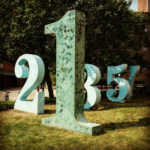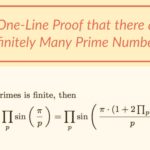Even Perfect Numbers and Mersenne Prime Numbers

Problem 496
Prove that if $2^n-1$ is a Mersenne prime number, then
\[N=2^{n-1}(2^n-1)\]
is a perfect number.
On the other hand, prove that every even perfect number $N$ can be written as $N=2^{n-1}(2^n-1)$ for some Mersenne prime number $2^n-1$.
Sponsored Links
Contents
Definitions.
In this post, a divisor of a positive integer means a positive divisor.
The Sum of Divisors Function $\sigma(n)$
For a positive integer $n$, we denote by $\sigma(n)$ the sum of all divisors of $n$.
(We call $\sigma$ the sum of the divisors function.)
For example, consider the number $12$.
The divisors of $12$ are $1, 2, 3, 4, 6, 12$.
Thus, the sum of the divisors of $12$ is
\[\sigma(12)=1+2+3+4+6+12=28.\]
Perfect Numbers
A positive integer $n$ is called a perfect number if the sum of all proper divisors are $n$ itself.
Here, a proper divisor of $n$ means a divisor of $n$ that is not $n$ itself.
Alternatively and equivalently, we can define a perfect number to be a positive integer $n$ such that the sum of all divisors of $n$ (including $n$ itself) is $2n$.
In terms of the function $\sigma(n)$, an integer $n$ is a perfect number if $\sigma(n)=2n$.
Examples of Perfect Numbers
For example, the number $6$ is the first perfect number.
In fact, the proper divisors of $6$ are $1, 2, 3$ and their sum is $1+2+3=6$.
We also can use the second equivalent definition to check that $6$ is a perfect number.
We have
\begin{align*}
\sigma(6)=1+2+3+6=12=2\cdot 6.
\end{align*}
The next perfect number is $28$.
To see this, we find the divisors of $28$ and sum them up, and we have
\[\sigma(28)=1+2+4+7+14+28=56=2\cdot 28.\]
(Wait, did you notice that this problem is posted on June 28th?
I propose to call June 28th Perfect Number Day or simply Perfect Day.)
Can you find the next perfect number?
I give you a hint: Look at the problem number of this post.
Yes, the third perfect number is
Unsolved Problems in Number Theory
All the perfect numbers people have found so far are all even numbers.
According to Wikipedia, 49 Mersenne primes are known as of January 2016.
Even though we don’t know whether there are infinitely even perfect numbers, we do know how they should look like thanks to the great mathematician Euclid and Euler.
This is the problem of this post.
Mersenne Prime Numbers
A number of the form $2^n-1$ is called a Mersenne number.
The first few Mersenne numbers are $1, 3, 7, 15, 31$, corresponding to $n=1, 2, 3, 4, 5$.
As you can see from these examples, not all Mersenne numbers are prime numbers.
If a Mersenne number is a prime number, then we call it a Mersenne prime number.
Thus $2^2-1=3, 2^3-1=7, 2^5-1=31$ are examples of Mersenne prime numbers, but $2^4-1=15=3\cdot 5$ is not a Mersenne prime number.
The problem claims that:
Conversely, if $N$ is an even perfect number, then there is a Mersenne number $2^n-1$ such that $N=2^{n-1}(2^n-1)$ (Euler proved this part).
Thus, even perfect numbers and Mersenne prime numbers are one-to-one correspondence: If you find one, then you find the other.
As we said earlier, we don’t know whether there are infinitely many perfect numbers.
Thus, we also don’t know whether there are infinitely many Mersenne prime numbers.
Properties of the Sum of Divisors Function $\sigma$
To prove the problem, let us first study the sum of divisors function $\sigma(n)$.
Then the sum of all the divisors of $n$ is given by the formula
\begin{align*}
\sigma(n)&=(1+p_1+p_1^2+\cdots+p_1^{a_1})\cdots (1+p_k+p_k^2+\cdots+p_k^{a_k})\\[6pt] &=\frac{p_1^{a_1+1}-1}{p_1-1}\cdots \frac{p_k^{a_k+1}-1}{p_k-1}.
\end{align*}
Using the product symbol $\prod$, we can write it concisely as
\[\sigma(n)=\prod_{i=1}^k \frac{p^{a_i+1}-1}{p_i-1}.\]
Example How to Use the Formula
Before the proof of Theorem, let us give an example to illustrate how to use the formula in Theorem.
Consider $24$.
The prime factorization is $24=2^3\cdot 3$.
Thus, by Theorem the sum of the divisors of $24$ is
\begin{align*}
\sigma(24)&=\frac{2^{3+1}-1}{2-1}\cdot \frac{3^{1+1}-1}{3-1}\\
&=15\cdot 4 =60.
\end{align*}
Just to make sure, let us list divisors of $24$:
\[1, 2, 3, 4, 6, 8, 12, 24\]
and it is checked that the sum of these divisors is $60$ and it (of course) coincides with the result we obtained using Theorem.
Proof of Theorem
From the prime factorization $n=p_1^{a_1}\dots p_k^{a_k}$, every divisor of $n$ is of the form
\[n=p_1^{b_1}\dots p_k^{b_k},\]
where $0 \leq b_i \leq a_i$ for $i=1, \dots, k$.
If the product
\[(1+p_1+p_1^2+\cdots+p_1^{a_1})\cdots (1+p_k+p_k^2+\cdots+p_k^{a_k})\]
is expanded, then this becomes some of
\[n=p_1^{b_1}\dots p_k^{b_k},\]
where each $b_i$ runs from $0$ to $a_k$.
Thus, it is the sum of the divisors of $n$.
This proves the first equality in the formula.
By the formula for a geometric series, we have
\begin{align*}
1+p_i+p_i^2+\cdots+p_i^{a_i}=\frac{p^{a_i+1}-1}{p_i-1}.
\end{align*}
This yields the second equality.
This completes the proof of Theorem.
As a corollary of this theorem, we see that the sum of the divisors function $\sigma(n)$ is multiplicative.
Then we have
\[\sigma(mn)=\sigma(m)\sigma(n).\]
Proof of Corollary
Let
\[m=p_1^{a_1}\dots p_k^{a_k} \text{ and } n=q_1^{b_1}\dots q_l^{b_l}\]
be the prime factorizations of $m$ and $n$.
Since $m$ and $n$ are relatively prime, each pair of $p_i$ and $q_j$ is distinct.
Thus,
\[nm=p_1^{a_1}\dots p_k^{a_k}q_1^{b_1}\dots q_l^{b_l}\]
is the prime factorization of $mn$.
By the theorem above, we have
\begin{align*}
\sigma(m)=\prod_{i=1}^k \frac{p^{a_i+1}-1}{p_i-1}\\[6pt]
\sigma(n)=\prod_{i=1}^l \frac{q^{b_i+1}-1}{q_i-1}
\end{align*}
and thus we have
\begin{align*}
\sigma(m)\sigma(n)=\prod_{i=1}^k \frac{p^{a_i+1}-1}{p_i-1}\cdot \prod_{i=1}^l \frac{q^{b_i+1}-1}{q_i-1}=\sigma(mn),
\end{align*}
where the second equality also follows from the theorem above.
This completes the proof of Corollary.
Proof of the Problem about Perfect Numbers and Mersenne Prime Numbers
If $2^n-1$ is a Mersenne Prime, then $2^{n-1}(2^n-1)$ is a Perfect Number
Suppose that $p:=2^n-1$ is a Mersenne prime number.
Then the sum of the divisors of $N=2^{n-1}p$ is
\begin{align*}
\sigma(N)&=\sigma(2^{n-1}p)\\
&=(1+2+2^2+\cdots+2^{n-2}+2^{n-1})(1+p) && \text{by Theorem}\\
&=(2^n-1)2^n\\
&=2\cdot 2^{n-1}(2^n-1)\\
&=2N.
\end{align*}
Therefore, the number $N$ is a perfect number.
If $N$ is an even perfect number, then $N=2^{n-1}(2^{n}-1)$ with Mersenne Prime $2^{n}-1$.
Suppose now that $N$ is an even perfect number.
Since $N$ is even, we can write
\[N=2^am\]
for some positive integers $a$ and an odd integer $m$.
Since $N$ is a perfect number, we have
\[\sigma(N)=2N=2^{a+1}m.\]
We compute
\begin{align*}
\sigma(N)&=\sigma(2^a)\sigma(m) &&\text{by Corollary}\\
&=(2^{a+1}-1)\sigma(m) &&\text{by Theorem}.
\end{align*}
Hence we have
\[2^{a+1}m=(2^{a+1}-1)\sigma(m).\]
Solving this to $\sigma(m)$, it yields that
\begin{align*}
\sigma(m)&=\frac{2^{a+1}m}{2^{a+1}-1}\\[6pt]
&=\frac{(2^{a+1}-1+1)m}{2^{a+1}-1}\\[6pt]
&=m+\frac{m}{2^{a+1}-1}.
\end{align*}
As both $\sigma(m)$ and $m$ are integers, so is $\frac{m}{2^{a+1}-1}$.
Since $a > 0$, the denominator $2^{a+1}-1 > 1$.
Hence $\frac{m}{2^{a+1}-1}$ is a proper divisor of $m$.
Now observe the equality we obtained above again:
\[\sigma(m)=m+\frac{m}{2^{a+1}-1}.\]
The left hand side $\sigma(m)$ is the sum of all the divisors of $m$.
The right hand side is the sum of two divisors of $m$: $m$ itself and $\frac{m}{2^{a+1}-1}$.
It follows that $m$ has only two divisors, and we must have
\[1=\frac{m}{2^{a+1}-1},\]
or equivalently
\[m=2^{a+1}-1.\]
The only integers that have exactly two divisors are prime numbers.
Thus, $m$ is a prime number, and it is of the form $m=2^{a+1}-1$.
Therefore $m$ is a Mersenne prime number, and the even perfect number $N$ can be written as
\[N=2^am=2^a(2^{a+1}-1)\]
with Mersenne prime $m=2^{a+1}-1$ as required.
This completes the proof of the problem.
The Largest Perfect Number
The largest Perfect Number we know is
with 44,677,235 digits.
By Problem, we know that
is the largest Mersenne prime number we know.
(Reference: Wikipedia)
Comments
I’m happy that I could post the 496th article about perfect numbers on the Perfect Day June 28th, 2017.
Is 2017 a perfect number?
No!! But 2017 is a prime number!!
 Add to solve later
Add to solve later
Sponsored Links



















1 Response
[…] From elementary number theory, all even perfect numbers are of the form [2^{p-1}(2^p-1),] where $p$ is a prime number and $2^p-1$ is also a prime number. (For a proof, see the post “Even Perfect Numbers and Mersenne Prime Numbers“.) […]